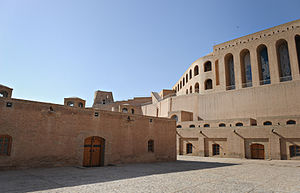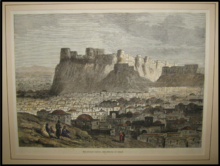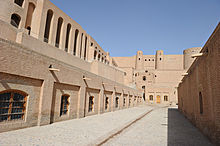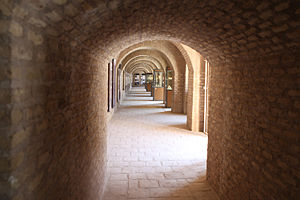- Herat Citadel
-
The Citadel of Herat, also known as the Citadel of Alexander, and locally known as Qala Iktyaruddin, is located in the center of Herat in Afghanistan. It dates back to 330 BC, when Alexander the Great and his army arrived to what is now Afghanistan after the Battle of Gaugamela. Many empires have used it as a headquarters in the last 2,000 years, and was destroyed and rebuilt many times over the centuries.
This historic citadel was saved from demolition in the 1950s, and was excavated and restored by UNESCO between 1976 and 1979.[1] From decades of wars and neglect, the citadel began to crumble but in recent years several international organizations decided to completely rebuild it. The National Museum of Herat is also housed inside the citadel, while the Afghan Ministry of Information and Culture is the caretaker of the whole premises.[2]
Contents
History
Herat, in the fertile valley of Hari River (Hari Rud), was settled as early as the sixth century BC. A mound located to the north of the Old City, known as Kuhandazh may have been the site of the fort that Alexander the Great built in 330 BC following his conquest of the Achaemenid city known as Artacoana or Aria. After the depart of Alexander, Herat was ruled by the Seleucids, Parthians, Kushans, Sasanians, Hephthalites, Umayyads, Tahirids, Saffarids, Samanids, Seljuk, Ghaznavids, and Ghurids.
Located half a kilometer to the south of Kuhandaz and aligned with the cardinal axes, the walled city described by early Arab geographers had four gates leading into crossing commercial avenues and a square citadel (qal'a) adjoining the northern city wall. This citadel, which has been suggested as another possible site for Alexander's fort, is known today as the famous Citadel of Herat.[3] Herat thrived with the Silk Road trade from the Levant to India and China, and became an important city of the Ghurid dynasty in 1175. The city was destroyed entirely in 1221 by the Mongol army and rebuilt by the Kartid governors who established their rule based in Herat by the mid-thirteenth century.[4]
Kartid Amir Fakhr al-Din (reg. 1295-1308) in 1299/1300 reinforced the citadel's towers, walls, ramparts and moat, and added a walled maidan to its west to serve as an open-air mosque (idgah). His successor Ghiyath al-Din (reg. 1308-1329) built two palaces inside the citadel to the east. The name Ikhtiyar al-Din, which refers to both the eastern and western enclosures, is thought to be the name or epithet of a Kartid amir or military commander. Destroyed a second time by Timur's army (1380), the citadel was rebuilt after Shah Rukh (reg. 1405-1444) moved his capital to Herat and began a building campaign. He reinforced the citadel in stone and fired brick and covered its exterior with glazed tiles.
The citadel was used as a royal residence, treasury, prison and arsenal under the Hotaki dynasty/Durrani Empire in the 18th century. It suffered some damage during the Anglo-Afghan War in the 19th century. A modern citadel (Arg-e Herat) was built immediately to its north in the mid-19th century to take over its defensive function. The citadel was saved from demolition in the 1950s, and was excavated and restored by UNESCO between 1976 and 1979.[5] It suffered more damages during the last decades of wars and neglect.
Recent restoration
The citadel of Herat was completely renovated in the last five years. It consists of two walled enclosures. The latest restoration involved hundreds of Afghan craftsmen and funds from the Aga Khan Trust for Culture and about $2.4 million from the U.S. and German governments.
The older compound to the east, found filled with debris, was partially excavated to reveal two courtyard structures. It has a roughly rectangular plan measuring about eighteen by forty-two meters, and it is protected with thirteen semi-circular towers, including two flanking a west-facing gate. It is also known as the Upper Citadel, based on its elevated site, and is built of fired bricks.
The Kartid addition to the west, known as the Lower Citadel, has lower walls of baked brick and includes Timurid period military structures. Its polygonal plan measures about twenty-five by sixty meters with nine circular towers, of which six survive along the south and west walls. The tall Malik Tower on its western wall is thought to be named after a Kartid malik and retains segments of its Timurid glazed tile decoration, including parts of a Kufic inscriptive band.
An Ethnographic Museum, a Military Museum, Handicraft Workshops and an Archaeological Museum were set up inside the Lower Citadel after the 1970s restoration, while the Upper Citadel was opened to visitors as an Open Air Archaeological Museum, with a northern section reconstructed as a traditional residence. About 1,100 items from the Herat region are stored inside the museum at the citadel, of which 250 are on display currently.[2]
At a ceremony in October 2011, U.S. Ambassador Ryan Crocker stated that: "Until 35 years ago, tourists from around the world came here to experience heritage, history and incomparable national landscapes... We look forward to the day when Afghans and visitors from around the world will once again come here to learn about Afghanistan's rich history and enjoy the great hospitality and beauty that this land and its people have to offer." Also present on the occasion was Afghan-expert Nancy Dupree and this is what she had to say: "I've been here many times, but it was crumbling... This is impressive.... I think the most exciting thing is to see something finally accomplished. I have seen so many half-finished things."[2]
References
- ^ "City of Herat - UNESCO World Heritage Centre". Whc.unesco.org. 2004-08-17. http://whc.unesco.org/en/tentativelists/1927/. Retrieved 2011-07-25.
- ^ a b c Restored citadel is symbol of hope in Afghanistan. Deb Riechmann. October 17, 2011.
- ^ "Citadel of Herat". Archnet.org. http://archnet.org/library/sites/one-site.jsp?site_id=11348. Retrieved 2011-07-25.
- ^ "Afghanistan Site 089. Herat: Qal'a-i Ikhtiyar al-Din". Cemml.colostate.edu. http://www.cemml.colostate.edu/cultural/09476/afgh05-089.html. Retrieved 2011-07-25.
- ^ "City of Herat - UNESCO World Heritage Centre". Whc.unesco.org. 2004-08-17. http://whc.unesco.org/en/tentativelists/1927/. Retrieved 2011-07-25.
External links
Categories:- Herat
- Forts
Wikimedia Foundation. 2010.




